Scale-Location Dependence Relationship between Soil Organic Matter and Environmental Factors by Anisotropy Analysis and Multiple Wavelet Coherence
Abstract
:1. Introduction
2. Materials and Methods
2.1. Study Area
2.2. Field Sampling and Environmental Data Collection
2.3. Transect Establishment
2.4. MWC and BWC
2.5. Assessment of Performance of Environmental Factors
3. Results
3.1. Characteristics of SOM and Environmental Factors
3.2. Single Environmental Factor Explaining SOM Variability
3.3. Multiple Environmental Factors Explaining SOM Variability
4. Discussion
4.1. Anisotropy and Scale-Location Specific Factors Explaining SOM
4.2. Can More Factors Be Included to Better Explain SOM Variability?
5. Conclusions
Author Contributions
Funding
Institutional Review Board Statement
Informed Consent Statement
Data Availability Statement
Acknowledgments
Conflicts of Interest
References
- Tiessen, H.; Cuevas, E.; Chacon, P. The role of soil organic matter in sustaining soil fertility. Nature 1994, 371, 783–785. [Google Scholar] [CrossRef]
- Davidson, E.A.; Janssens, I.A. Temperature sensitivity of soil carbon decomposition and feedbacks to climate change. Nature 2006, 440, 165–173. [Google Scholar] [CrossRef] [PubMed] [Green Version]
- Biswas, A. Scale–location specific soil spatial variability: A comparison of continuous wavelet transform and Hilbert-Huang transform. Catena 2018, 160, 24–31. [Google Scholar] [CrossRef]
- Bonfatti, B.R.; Hartemink, A.E.; Giasson, E.; Tornquist, G.C.; Adhikari, K. Digital mapping of soil carbon in a viticultural region of southern brazil. Geoderma 2016, 261, 204–221. [Google Scholar] [CrossRef]
- Guan, J.H.; Deng, L.; Zhang, J.G.; He, Q.Y.; Shi, W.Y.; Li, G.; Du, S. Soil organic carbon density and its driving factors in forest ecosystems across a northwestern province in China. Geoderma 2019, 352, 1–12. [Google Scholar] [CrossRef]
- Mishra, U.; Hugelius, G.; Shelef, E.; Yang, Y.; Strauss, J.; Lupachev, A.; Harden, J.M.; Jastrow, J.D.; Ping, C.L.; Riley, W.J.; et al. Spatial heterogeneity and environmental predictors of permafrost region soil organic carbon stocks. Sci. Adv. 2021, 7, 5236. [Google Scholar] [CrossRef]
- Zeleke, T.B.; Si, B.C. Characterizing scale-dependent spatial relationships between soil properties using multifractal techniques. Geoderma 2006, 134, 440–452. [Google Scholar] [CrossRef]
- Webster, R. Spectral analysis of gilgai soil. Aust. J. Soil Res. 1977, 15, 191–204. [Google Scholar] [CrossRef]
- Guo, Y.D.; Zhao, R.Y.; Zeng, Y.N.; Shi, Z.; Zhou, Q. Identifying scale-specific controls of soil organic matter distribution in mountain areas using anisotropy analysis and discrete wavelet transform. Catena 2018, 160, 1–9. [Google Scholar] [CrossRef]
- Zhu, H.F.; Hu, W.; Jing, Y.D.; Cao, Y.; Bi, R.T.; Yang, W.D. Soil organic carbon prediction based on scale-specific relationships with environmental factors by discrete wavelet transform. Geoderma 2018, 330, 9–18. [Google Scholar] [CrossRef]
- Biswas, A.; Cresswell, H.P.; Viscarra Rossel, R.A.; Si, B.C. Separating scale-specific spatial variability in two dimensions using bi-dimensional empirical mode decomposition. Soil Sci. Soc. Am. J. 2013, 77, 1991. [Google Scholar] [CrossRef]
- Zhou, Y.; Chen, S.C.; Zhu, A.X.; Hu, B.F.; Shi, Z.; Li, Y. Revealing the scale- and location-specific controlling factors of soil organic carbon in Tibet. Geoderma 2021, 382, 114713. [Google Scholar] [CrossRef]
- Biswas, A.; Cresswell, H.P.; Rossel, R.V.; Si, B.C. Characterizing scale- and location-specific variation in non-linear soil systems using the wavelet transform. Eur. J. Soil Sci. 2013, 64, 706–715. [Google Scholar] [CrossRef]
- Bahri, H.; Raclot, D.; Barbouchi, M.; Lagacherie, P.; Annabi, M. Mapping soil organic carbon stocks in Tunisian topsoils. Geoderma Reg. 2022, 30, e00561. [Google Scholar] [CrossRef]
- Koopman, L.H. The Spectral Analysis of Time Series; Academic Press: Cambridge, MA, USA, 1974; pp. 119–164. [Google Scholar]
- Si, B.C. Spatial scaling analyses of soil physical properties: A review of spectral and wavelet methods. Vadose Zone J. 2008, 7, 547. [Google Scholar] [CrossRef] [Green Version]
- Fleureau, J.; Kachenoura, A.; Albera, L.; Nunes, J.; Senhadji, L. Multivariate empirical mode decomposition and application to multichannel filtering. Signal Process. 2011, 91, 2783–2792. [Google Scholar] [CrossRef] [Green Version]
- Zhu, H.F.; Cao, Y.; Jing, Y.D.; Liu, G.; Bi, R.; Yang, W.D. Multi-scale spatial relationships between soil total nitrogen and influencing factors in a basin landscape based on multivariate empirical mode decomposition. J. Arid Land 2019, 11, 385–399. [Google Scholar] [CrossRef] [Green Version]
- Zhu, X.C.; Liang, Y.; Tian, Z.Y.; Wang, X. Analysis of scale-specific factors controlling soil erodibility in southeastern China using multivariate empirical mode decomposition. Catena 2021, 199, 105131. [Google Scholar] [CrossRef]
- Hu, W.; Si, B.C. Technical note: Multiple wavelet coherence for untangling scale specific and localized multivariate relationships in geosciences. Hydrol. Earth Syst. Sci. 2016, 20, 3183–3191. [Google Scholar] [CrossRef] [Green Version]
- Agarwal, A.; Marwan, N.; Rathinasamy, M.; Merz, B.; Kurths, J. Multi-scale event synchronization analysis for unravelling climate processes: A wavelet-based approach. Nonlin. Process. Geophys. 2017, 24, 599–611. [Google Scholar] [CrossRef]
- Centeno, L.N.; Hu, W.; Timm, L.C.; She, D.; da Silva Ferreira, A.; Barros, W.S.; Beskow, S.; Caldeira, T.L. Dominant control of macroporosity on saturated soil hydraulic conductivity at multiple scales and locations revealed by wavelet analyses. J. Soil Sci. Plant Nutr. 2020, 20, 1686–1702. [Google Scholar] [CrossRef]
- Trangmar, B.B.; Yost, R.S.; Uehara, G. Application of geostatistics to spatial studies of soil properties. Adv. Agron. 1985, 38, 45–94. [Google Scholar] [CrossRef]
- Burgess, T.M.; Webster, R. Optimal interpolation and isarithmic mapping of soil properties. I. The semivariogram and punctual kriging. Eur. J. Soil Sci. 2019, 31, 315–331. [Google Scholar] [CrossRef]
- Biswas, A.; Cresswell, H.P.; Viscarra Rossel, R.A.; Si, B.C. Curvelet transform to study scale-dependent anisotropic soil spatial variation. Geoderma 2014, 213, 589–599. [Google Scholar] [CrossRef]
- Simon, G. An angular version of spatial correlations with exact significance tests. Geogr. Anal. 1997, 29, 267–278. [Google Scholar] [CrossRef]
- Zhao, R.; Biswas, A.; Zhou, Y.; Zhou, Y.; Shi, Z.; Li, H. Identifying localized and scale-specific multivariate controls of soil organic matter variations using multiple wavelet coherence. Sci. Total Environ. 2018, 643, 548–558. [Google Scholar] [CrossRef]
- Zhu, H.F.; Hu, W.; Ding, H.X.; Lv, C.J.; Bi, R.T. Scale- and location-specific multivariate controls of topsoil organic carbon density depend on landform heterogeneity. Catena 2021, 207, 105695. [Google Scholar] [CrossRef]
- Tian, H.W.; Zhang, J.H.; Zhu, L.Q.; Liu, M.; Shi, J.Q.; Li, G.D. Revealing the scale- and location-specific relationship between soil organic carbon and environmental factors in China’s north-south transition zone. Geoderma 2022, 409, 115600. [Google Scholar] [CrossRef]
- Huang, J.Y.; Shi, Z.; Biswas, A. Characterizing anisotropic scale-specific variations in soil salinity from a reclaimed marshland in China. Catena 2015, 131, 64–73. [Google Scholar] [CrossRef]
- Grinsted, A.; Moore, J.C.; Jevrejeva, S. Application of the cross wavelet transform and wavelet coherence to geophysical time series. Nonlin. Process. Geophys. 2004, 11, 561–566. [Google Scholar] [CrossRef]
- Zhuo, Z.Q.; Chen, Q.Q.; Zhang, X.L.; Chen, S.C.; Gou, Y.X.; Sun, Z.X.; Huang, Y.F.; Shi, Z. Soil organic carbon storage, distribution, and influencing factors at different depths in the dryland farming regions of Northeast and North China. Catena 2022, 210, 105934. [Google Scholar] [CrossRef]
- Augustin, C.; Cihacek, L.J. Relationships between soil carbon and soil texture in the Northern Great Plains. Soil Sci. 2007, 181, 386–392. [Google Scholar] [CrossRef]
- Liu, Z.P.; Shao, M.A.; Wang, Y.Q. Estimating soil organic carbon across a large-scale region: A state-space modeling approach. Soil Sci. 2012, 177, 607–618. [Google Scholar] [CrossRef]
- Heimann, M.; Reichstein, M. Terrestrial ecosystem carbon dynamics and climate feedbacks. Nature 2008, 451, 289–292. [Google Scholar] [CrossRef] [PubMed] [Green Version]
- Carey, C.J.; Weverka, J.; Digaudio, R.; Gardali, T.; Porzig, E.L. Exploring variability in rangeland soil organic carbon stocks across California (USA) using a voluntary monitoring network. Geoderma Reg. 2020, 22. [Google Scholar] [CrossRef]
- Grimm, R.; Behrens, T.; Marker, M.; Elsenbeer, H. Soil organic carbon concentrations and stocks on Barro Colorado Island-digital soil mapping using random forests analysis. Geoderma 2008, 146, 102–113. [Google Scholar] [CrossRef]
- Zhang, S.W.; Huang, Y.F.; Shen, C.Y.; Ye, H.C.; Du, Y.C. Spatial prediction of soil organic matter using terrain indices and categorical variables as auxiliary information. Geoderma 2012, 171, 35–43. [Google Scholar] [CrossRef]
- Chen, L.; He, Z.; Du, J.; Yang, J.; Zhu, X. Patterns and environmental controls of soil organic carbon and total nitrogen in alpine ecosystems of northwestern China. Catena 2016, 137, 37–43. [Google Scholar] [CrossRef]
- Zhou, Y.; Biswas, A.; Ma, Z.; Lu, Y.; Chen, Q.; Shi, Z. Revealing the scale-specific controls of soil organic matter at large scale in Northeast and North China Plain. Geoderma 2018, 271, 71–79. [Google Scholar] [CrossRef]
- Schillaci, C.; Acutis, M.; Lombardo, L.; Lipani, A.; Fantappie, M.; Marker, M.; Saia, S. Spatio-temporal topsoil organic carbon mapping of a semi-arid Mediterranean region: The role of land use, soil texture, topographic indices and the influence of remote sensing data to modelling. Sci. Total Environ. 2017, 601–602, 821–832. [Google Scholar] [CrossRef]
- Wiesmeier, M.; Urbanski, L.; Hobley, E.; Lang, B.; von Lützow, M.; Marin-Spiotta, E.; van Wesemael, B.; Rabot, E.; Ließ, M.; Garcia-Franco, N.; et al. Soil organic carbon storage as a key function of soils–a review of drivers and indicators at various scales. Geoderma 2019, 333, 149–162. [Google Scholar] [CrossRef]
- Adhikari, K.; Mishra, U.; Owens, P.R.; Libohova, Z.; Wills, S.A.; Riley, W.J.; Hoffman, F.M.; Smith, D.R. Importance and strength of environmental controllers of soil organic carbon changes with scale. Geoderma 2020, 375, 114472. [Google Scholar] [CrossRef]
- Hu, W.; Si, B.C.; Biswas, A.; Chau, H.W. Temporally stable patterns but seasonal dependent controls of soil water content: Evidence from wavelet analyses. Hydrol. Process. 2017, 31, 3697–3707. [Google Scholar] [CrossRef]
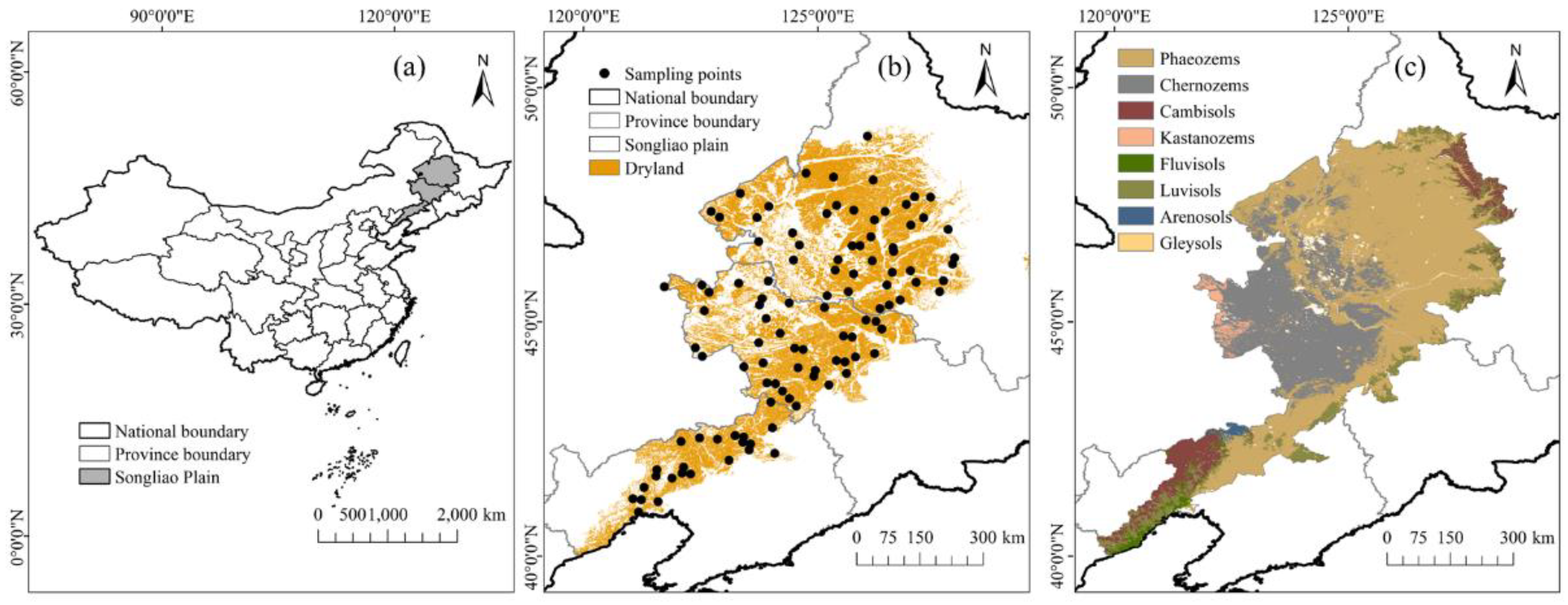

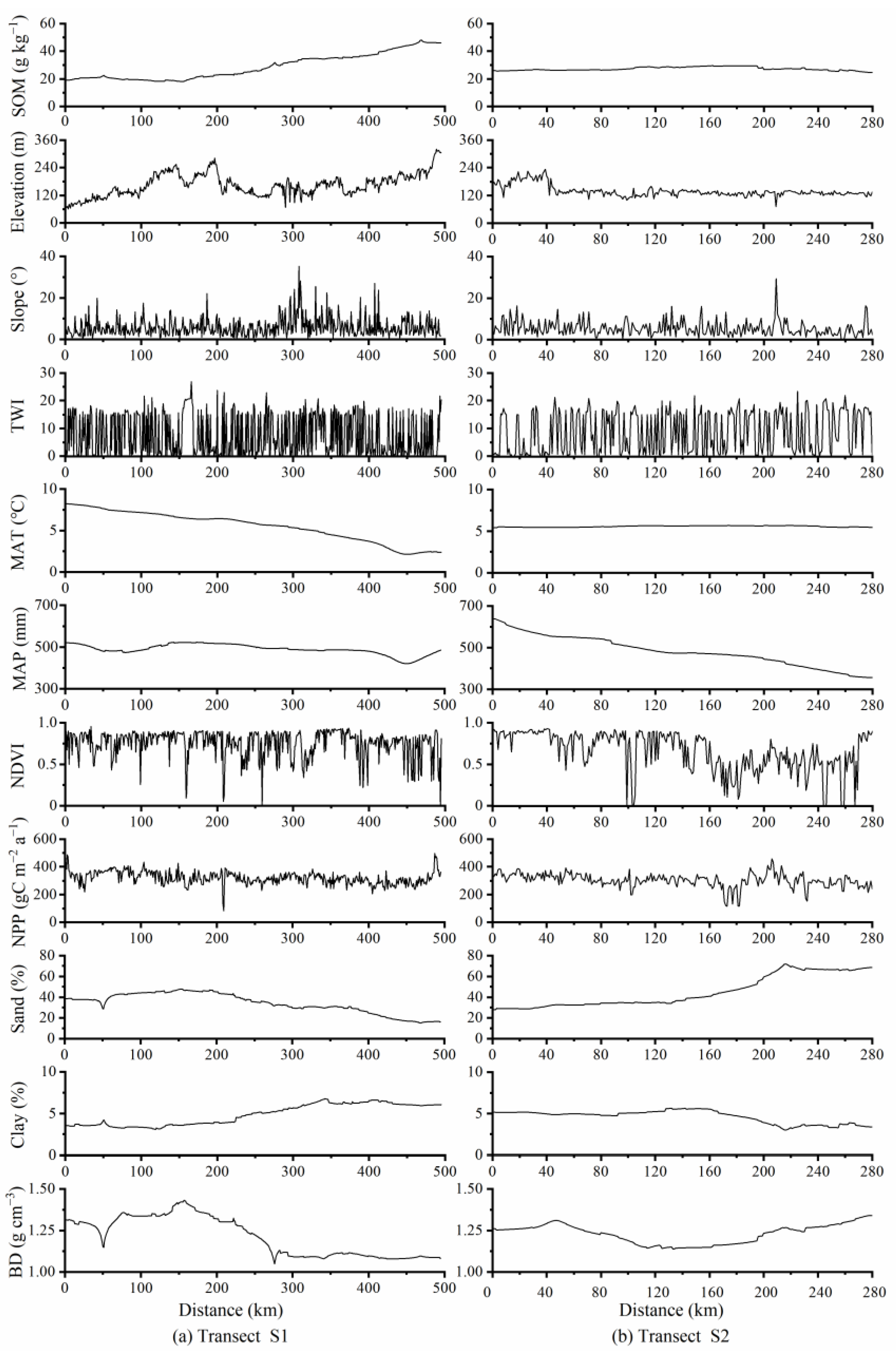
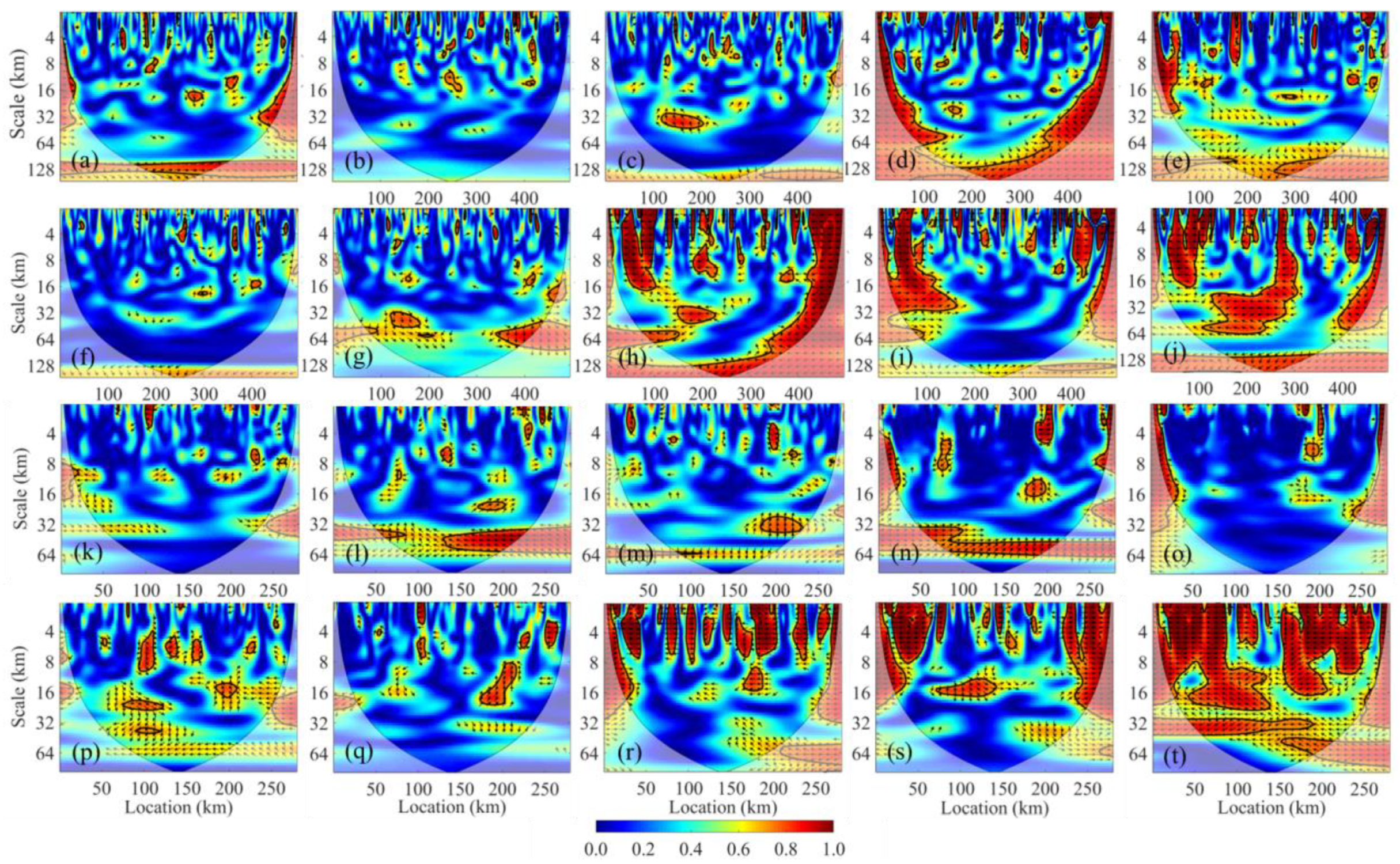
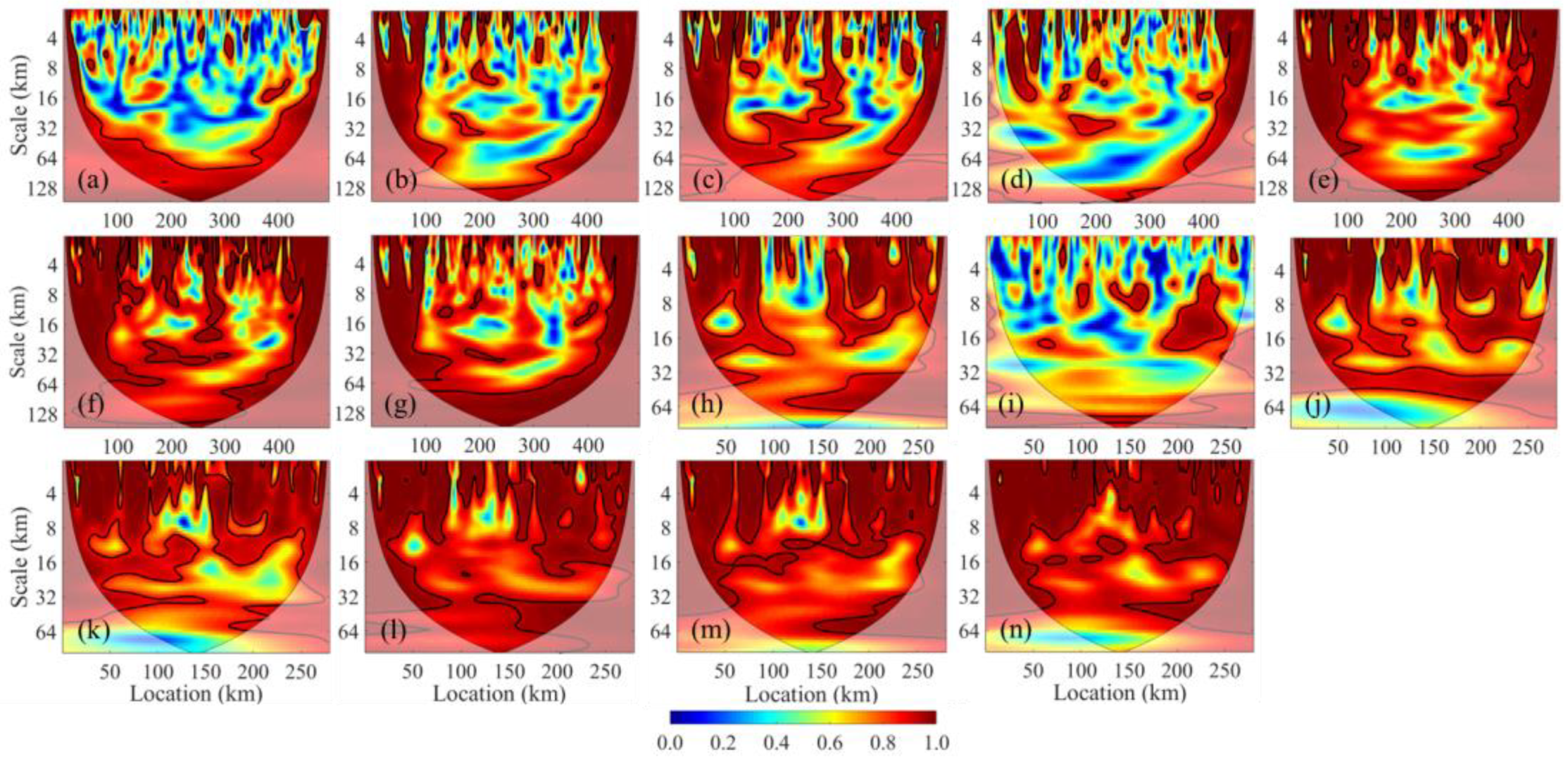

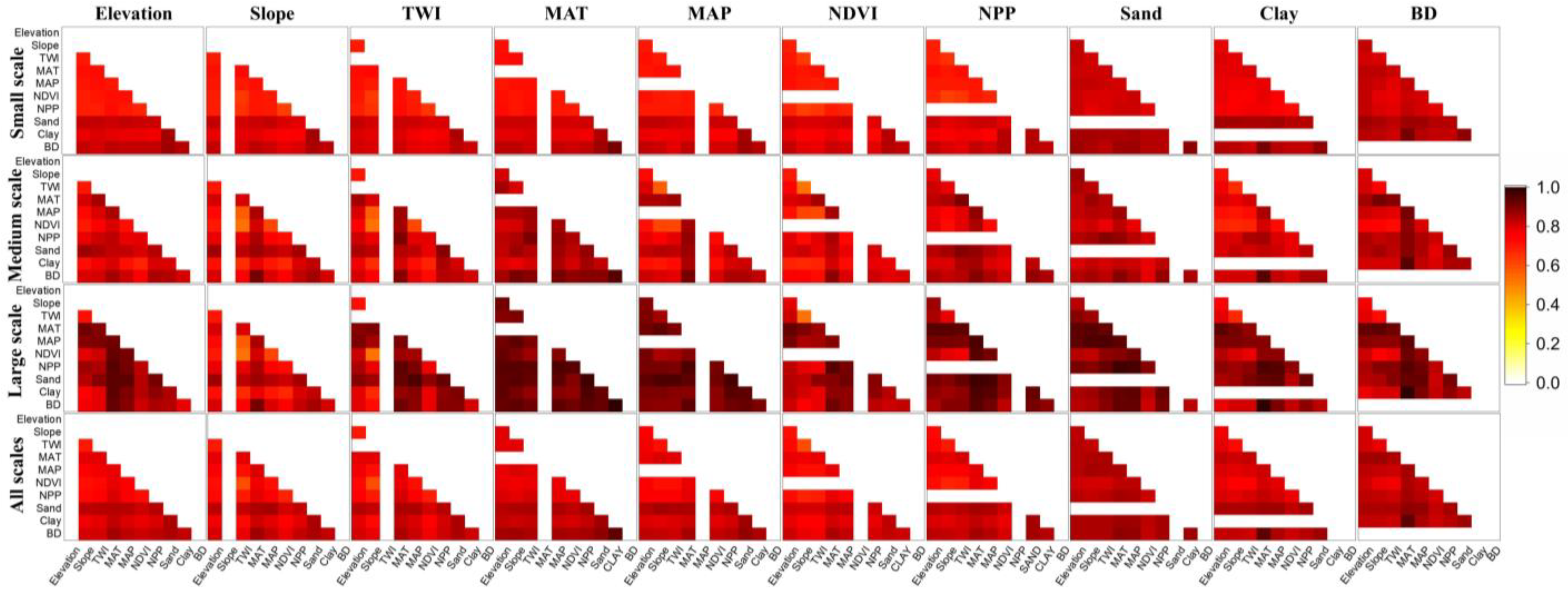
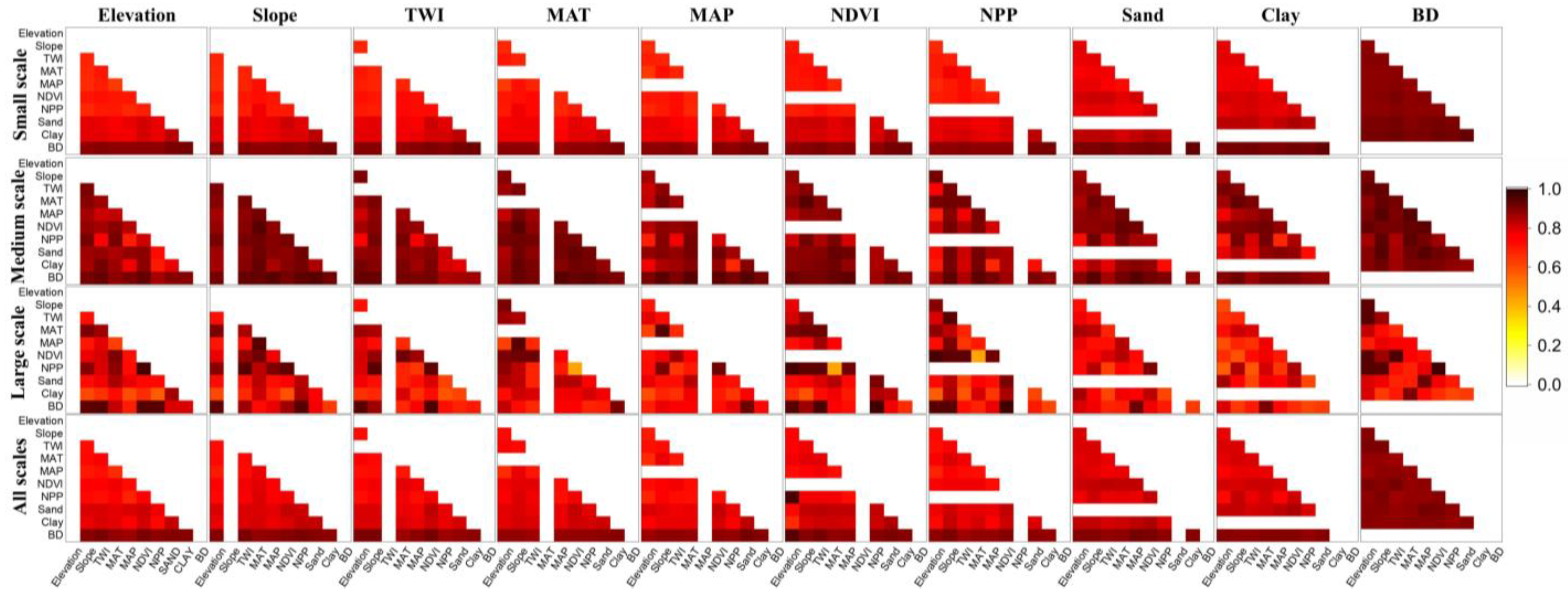
| Transect | SOM (g kg−1) | Elevation (m) | Slope (°) | TWI | MAT (°C) | MAP (mm) | NDVI | NPP (gC m−2 a−1) | Sand (%) | Clay (%) | BD (g cm−3) | |
|---|---|---|---|---|---|---|---|---|---|---|---|---|
| S1 | Mean | 28.84 | 164.48 | 5.88 | 7.55 | 5.50 | 489.27 | 0.75 | 320.03 | 34.17 | 4.85 | 1.21 |
| Minmum | 18.02 | 61.00 | 0.00 | 0.01 | 2.13 | 420.70 | 0.00 | 82.40 | 15.07 | 3.08 | 1.05 | |
| Maxmum | 48.03 | 320.00 | 35.24 | 26.86 | 8.22 | 522.54 | 0.95 | 496.60 | 47.67 | 6.77 | 1.43 | |
| Deviation | 9.22 | 49.02 | 4.65 | 7.52 | 1.79 | 24.65 | 0.17 | 54.11 | 9.65 | 1.24 | 0.12 | |
| CV (%) | 31.98 | 29.80 | 78.97 | 99.63 | 32.59 | 5.04 | 22.58 | 14.44 | 28.25 | 25.47 | 9.67 | |
| S2 | Mean | 27.22 | 138.95 | 5.36 | 8.75 | 5.55 | 482.50 | 0.65 | 303.41 | 45.11 | 4.60 | 1.23 |
| Minmum | 24.58 | 72.00 | 0.00 | 0.13 | 5.41 | 356.03 | 0.00 | 114.40 | 27.97 | 2.99 | 1.14 | |
| Maxmum | 29.75 | 233.00 | 29.35 | 23.33 | 5.67 | 639.25 | 0.93 | 457.40 | 72.05 | 5.64 | 1.34 | |
| Deviation | 1.30 | 24.97 | 3.65 | 7.69 | 0.08 | 71.19 | 0.24 | 49.65 | 14.99 | 0.76 | 0.06 | |
| CV (%) | 4.76 | 17.97 | 68.05 | 87.83 | 1.50 | 14.75 | 36.49 | 16.36 | 33.23 | 16.53 | 4.70 |
| Transect | Factor | Small Scale (<32 km) | Medium Scale (32–64 km) | Large Scale (>64 km) | All Scales | ||||
|---|---|---|---|---|---|---|---|---|---|
| AWC | PASC(%) | AWC | PASC(%) | AWC | PASC(%) | AWC | PASC(%) | ||
| S1 | Elevation | 0.33 | 10.43 | 0.33 | 10.62 | 0.58 | 31.08 | 0.39 | 14.96 |
| Slope | 0.25 | 3.12 | 0.22 | 0.00 | 0.27 | 0.00 | 0.25 | 1.96 | |
| TWI | 0.27 | 4.40 | 0.20 | 6.43 | 0.15 | 0.00 | 0.23 | 3.76 | |
| MAT | 0.39 | 20.24 | 0.60 | 49.23 | 0.75 | 70.65 | 0.50 | 35.69 | |
| MAP | 0.36 | 11.77 | 0.34 | 0.00 | 0.68 | 31.94 | 0.43 | 14.36 | |
| NDVI | 0.24 | 1.84 | 0.18 | 0.00 | 0.28 | 0.00 | 0.24 | 1.16 | |
| NPP | 0.27 | 2.91 | 0.57 | 29.43 | 0.43 | 5.28 | 0.35 | 7.51 | |
| Sand | 0.53 | 32.17 | 0.55 | 40.39 | 0.70 | 63.76 | 0.57 | 40.32 | |
| Clay | 0.48 | 31.17 | 0.41 | 20.56 | 0.42 | 5.01 | 0.46 | 23.84 | |
| BD | 0.55 | 36.07 | 0.58 | 33.74 | 0.61 | 46.25 | 0.57 | 37.93 | |
| S2 | Elevation | 0.28 | 3.86 | 0.28 | 3.01 | 0.15 | 0.00 | 0.27 | 3.31 |
| Slope | 0.27 | 1.98 | 0.70 | 45.60 | 0.22 | 0.00 | 0.34 | 9.47 | |
| TWI | 0.29 | 3.77 | 0.31 | 6.13 | 0.21 | 0.00 | 0.28 | 3.80 | |
| MAT | 0.29 | 11.12 | 0.64 | 55.98 | 0.22 | 0.00 | 0.34 | 17.89 | |
| MAP | 0.29 | 13.83 | 0.25 | 0.71 | 0.34 | 0.00 | 0.29 | 10.09 | |
| NDVI | 0.35 | 7.98 | 0.49 | 1.40 | 0.22 | 0.00 | 0.36 | 6.00 | |
| NPP | 0.27 | 5.41 | 0.30 | 0.00 | 0.16 | 0.00 | 0.27 | 3.90 | |
| Sand | 0.49 | 28.47 | 0.39 | 8.63 | 0.46 | 8.83 | 0.47 | 22.95 | |
| Clay | 0.50 | 31.72 | 0.39 | 1.64 | 0.22 | 0.00 | 0.45 | 23.15 | |
| BD | 0.72 | 58.77 | 0.58 | 37.11 | 0.32 | 12.30 | 0.66 | 50.16 | |
| Transect | Factor | Small Scale (<32 km) | Medium Scale (32–64 km) | Large Scale (>64 km) | All Scales | ||||
|---|---|---|---|---|---|---|---|---|---|
| AWC | PASC(%) | AWC | PASC(%) | AWC | PASC(%) | AWC | PASC(%) | ||
| S1 | MAT + NPP | 0.56 | 17.85 | 0.79 | 54.16 | 0.93 | 94.07 | 0.68 | 40.05 |
| MAT + Sand | 0.71 | 35.06 | 0.76 | 48.05 | 0.88 | 69.48 | 0.75 | 44.56 | |
| MAT+BD | 0.74 | 40.15 | 0.83 | 57.64 | 0.88 | 55.67 | 0.78 | 46.23 | |
| NDVI + Sand | 0.78 | 25.98 | 0.75 | 23.57 | 0.83 | 27.36 | 0.76 | 25.91 | |
| MAT + Sand + CLAY | 0.85 | 43.22 | 0.82 | 39.07 | 0.93 | 62.91 | 0.86 | 46.87 | |
| MAT + Sand + BD | 0.87 | 46.92 | 0.89 | 50.86 | 0.94 | 54.76 | 0.89 | 49.23 | |
| NPP + MAT + Sand | 0.81 | 32.67 | 0.87 | 48.91 | 0.98 | 93.38 | 0.86 | 48.40 | |
| S2 | MAP+BD | 0.82 | 50.82 | 0.88 | 57.77 | 0.63 | 9.95 | 0.81 | 47.84 |
| NDVI+NPP | 0.54 | 7.33 | 0.61 | 0.06 | 0.80 | 12.35 | 0.58 | 6.56 | |
| Sand + BD | 0.85 | 57.84 | 0.81 | 59.40 | 0.59 | 3.32 | 0.82 | 52.51 | |
| Clay + BD | 0.87 | 62.05 | 0.82 | 40.12 | 0.53 | 1.89 | 0.82 | 51.99 | |
| MAP + Sand + BD | 0.90 | 51.14 | 0.95 | 59.64 | 0.93 | 22.35 | 0.92 | 49.68 | |
| MAP + Clay + BD | 0.91 | 53.72 | 0.91 | 45.18 | 0.74 | 3.06 | 0.89 | 47.00 | |
| Sand + Clay + BD | 0.93 | 62.37 | 0.88 | 40.95 | 0.64 | 0.00 | 0.89 | 52.17 | |
Publisher’s Note: MDPI stays neutral with regard to jurisdictional claims in published maps and institutional affiliations. |
© 2022 by the authors. Licensee MDPI, Basel, Switzerland. This article is an open access article distributed under the terms and conditions of the Creative Commons Attribution (CC BY) license (https://creativecommons.org/licenses/by/4.0/).
Share and Cite
Gou, Y.; Liu, D.; Liu, X.; Zhuo, Z.; Shen, C.; Liu, Y.; Cao, M.; Huang, Y. Scale-Location Dependence Relationship between Soil Organic Matter and Environmental Factors by Anisotropy Analysis and Multiple Wavelet Coherence. Sustainability 2022, 14, 12569. https://doi.org/10.3390/su141912569
Gou Y, Liu D, Liu X, Zhuo Z, Shen C, Liu Y, Cao M, Huang Y. Scale-Location Dependence Relationship between Soil Organic Matter and Environmental Factors by Anisotropy Analysis and Multiple Wavelet Coherence. Sustainability. 2022; 14(19):12569. https://doi.org/10.3390/su141912569
Chicago/Turabian StyleGou, Yuxuan, Dong Liu, Xiangjun Liu, Zhiqing Zhuo, Chongyang Shen, Yunjia Liu, Meng Cao, and Yuangfang Huang. 2022. "Scale-Location Dependence Relationship between Soil Organic Matter and Environmental Factors by Anisotropy Analysis and Multiple Wavelet Coherence" Sustainability 14, no. 19: 12569. https://doi.org/10.3390/su141912569





